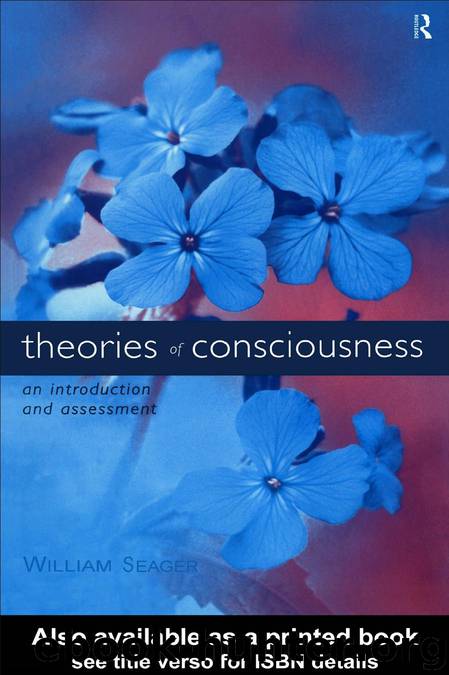Theories of Consciousness by William Seager

Author:William Seager
Language: eng
Format: mobi, epub
Tags: Humanities
Published: 2011-05-06T20:28:12.920419+00:00
164
REPRESENTATIONAL THEORIES II
about within the system. Yet they all play their part in servicing the ‘construction of representations ’. One demand of the generation problem is to explain why a
only some of a group of otherwise similar entities become conscious.
The simplest example of this problem that I can think of arises in something as common as stereo vision. Hold up a bookmark before you at arm’s length in front of a patterned background. Shut your left eye and look through your right eye alone; now do the reverse. The two views are distinctly different and they are different again from the combined stereo view provided by both eyes. Of course, there is a sense of depth in the latter view missing from either view from a single eye but the views are different in more basic information content. A schematic example is given in fig. 7.2.
(Fig. 7.2)
Each of these is a distinct representations, each of them can enter consciousness and the representation provided by both eyes is evidently some kind of combination of the representations from each eye. Note how the information about the background is integrated into a view containing information which neither eye can provide by itself. There is every reason to think that the representations from each eye remain active within the system during stereo vision, but they are no longer conscious representations. It is equally obvious that these representations continue to service the construction of representations , a
i.e. beliefs about the world. So Dretske owes us an account of what makes only some of the representations which serve to construct representations conscious a
s
while others remain non-conscious. This is a particular form of an extremely general problem of consciousness which no theory has successfully solved and upon which it seems the representational theory achieves no advance. With no answer to this question, the pure generation problem remains inviolate. What makes representations conscious? This mystery remains as deep as ever.
There is no end to these mysteries. Consider that, once a representation
‘makes it’ into consciousness, it will present to us a feature of the world as our cognitive system represents the world. As Dretske says, there is no problem in
‘knowing what you believe and experience’ (1995, p. 54). There is nonetheless a problem, as the passage continues: ‘the problem is in knowing that you believe and experience it’. Dretske then goes on to consider relatively benign instances of this difficulty. But there is a huge problem lurking here, which Dretske does not address until much later, in the very last chapter of his book.
Box 7.5 • Introducing Swampman
According to bio-functionalism (and many other theories of representation too), whether a state is a representation or not depends upon its standing in certain crucial relations to things entirely external to the representational system.
According to the representational theory of consciousness, all consciousness is representational in nature. A system that was incapable of representing anything could not be, even to the slightest degree, conscious. This suggests a variety of ‘rogue consciousness’ thought experiments,
Download
This site does not store any files on its server. We only index and link to content provided by other sites. Please contact the content providers to delete copyright contents if any and email us, we'll remove relevant links or contents immediately.
| Deconstruction | Existentialism |
| Humanism | Phenomenology |
| Pragmatism | Rationalism |
| Structuralism | Transcendentalism |
| Utilitarianism |
The remains of the day by Kazuo Ishiguro(7593)
Tools of Titans by Timothy Ferriss(6994)
The Black Swan by Nassim Nicholas Taleb(6229)
Inner Engineering: A Yogi's Guide to Joy by Sadhguru(5927)
Giovanni's Room by James Baldwin(5921)
The Way of Zen by Alan W. Watts(5822)
The Six Wives Of Henry VIII (WOMEN IN HISTORY) by Fraser Antonia(4809)
The Power of Now: A Guide to Spiritual Enlightenment by Eckhart Tolle(4787)
Astrophysics for People in a Hurry by Neil DeGrasse Tyson(4638)
Asking the Right Questions: A Guide to Critical Thinking by M. Neil Browne & Stuart M. Keeley(4619)
12 Rules for Life by Jordan B. Peterson(3769)
The Ethical Slut by Janet W. Hardy(3528)
Skin in the Game by Nassim Nicholas Taleb(3496)
Housekeeping by Marilynne Robinson(3437)
The Art of Happiness by The Dalai Lama(3404)
Double Down (Diary of a Wimpy Kid Book 11) by Jeff Kinney(3296)
Skin in the Game: Hidden Asymmetries in Daily Life by Nassim Nicholas Taleb(3284)
Walking by Henry David Thoreau(3244)
12 Rules for Life: An Antidote to Chaos by Jordan B. Peterson(3214)
